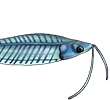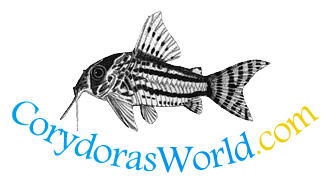Using Alder cones
-
strawbx
- Posts: 26
- Joined: 22 Apr 2004, 11:55
- Location 1: Chesterfield, UK
- Interests: Aquatics\Computers
Using Alder cones
Can anybody explain use of Alder cones as anti fungal agent re Cory eggs.
Do they have to be removed within a certain time period?
Is a water change crucial?
Alan.
Do they have to be removed within a certain time period?
Is a water change crucial?
Alan.
- Coryman
- Expert
- Posts: 2119
- Joined: 30 Dec 2002, 19:06
- My articles: 12
- My catfish: 5
- My cats species list: 83 (i:0, k:0)
- My BLogs: 1 (i:0, p:1)
- Spotted: 194
- Location 1: Kidderminster UK
- Location 2: Kidderminster, UK
- Interests: Cory's, Loricariids, photography and more Cory's
- Contact:
Alder cones
I put 2-3 litres of water from the spawning tank into a hatching container and add the collected eggs, I then put in 2 Alder cones. After two days I remove the cones, by this time they have done what there work protecting the eggs from fungal attack. On day three I will change 50% of the water replacing the removed water with water from the spawning tank.
Ian
Ian
-
Bwhiskered
- Posts: 87
- Joined: 01 Feb 2007, 21:47
- My cats species list: 1 (i:0, k:0)
- My Wishlist: 1
- Spotted: 3
- Location 1: Burlington,Ontario,Canada
- Interests: Fish, Fishing, Gardening
Alder Cones
I use the European Black Alder Cones to protect cory eggs and pleco eggs that get kicked out of caves. The tannic acid in the cones is the main ingredient that does the job of protecting eggs from fungus. I have been experimenting and have used it to make water acidic to spawn tetras and other fish that like acid water. I find that one cone can drop four litres of R.O. water to a PH of 6 over night. The water needs to be changed back to more alkaline water gradually to avoid PH shock.
I am sure that most of my fellow hobbyist to the south of me in the U.S. do not know that the European Black Alder grows as an invasive species along the Eastern Seaboard right up into Ontario Canada where I live. I am sure Ian Fuller when he first mentioned them in one of his talks at the Laural Maryland Catfish Convention did not know it either. Many years ago there was a catfish expert that advocated oak leaves and the latest fad for betta buffs is almond leaves. The basic ingredient is tannic acid but each one could have various other properties that protect eggs.
I am sure that most of my fellow hobbyist to the south of me in the U.S. do not know that the European Black Alder grows as an invasive species along the Eastern Seaboard right up into Ontario Canada where I live. I am sure Ian Fuller when he first mentioned them in one of his talks at the Laural Maryland Catfish Convention did not know it either. Many years ago there was a catfish expert that advocated oak leaves and the latest fad for betta buffs is almond leaves. The basic ingredient is tannic acid but each one could have various other properties that protect eggs.
Good fish are spawned and raised in Burlington.
- apistomaster
- Posts: 4735
- Joined: 10 Jun 2006, 14:26
- I've donated: $90.00!
- My articles: 1
- My cats species list: 12 (i:0, k:0)
- My Wishlist: 1
- Location 1: Clarkston, WA, USA
- Location 2: Clarkston, WA, USA
- Interests: Aquaculture and flyfishing
- Coryman
- Expert
- Posts: 2119
- Joined: 30 Dec 2002, 19:06
- My articles: 12
- My catfish: 5
- My cats species list: 83 (i:0, k:0)
- My BLogs: 1 (i:0, p:1)
- Spotted: 194
- Location 1: Kidderminster UK
- Location 2: Kidderminster, UK
- Interests: Cory's, Loricariids, photography and more Cory's
- Contact:
Bwhiskered,
To be truthful I did actually research to see if the Alder was native in North America before using it in my talks on your side of the pond. In fact when I went to London Toronto, at the auction on Sunday after my Talks on Saturday there were several bags of Alder cone on offer. Now that was a bit of quick thinking.
The original tip about using them was given to me by Hans-Georg Evers while I was visiting him in Hamburg a couple of years ago and a very valuable tip too.
Ian
To be truthful I did actually research to see if the Alder was native in North America before using it in my talks on your side of the pond. In fact when I went to London Toronto, at the auction on Sunday after my Talks on Saturday there were several bags of Alder cone on offer. Now that was a bit of quick thinking.
The original tip about using them was given to me by Hans-Georg Evers while I was visiting him in Hamburg a couple of years ago and a very valuable tip too.
Ian
- apistomaster
- Posts: 4735
- Joined: 10 Jun 2006, 14:26
- I've donated: $90.00!
- My articles: 1
- My cats species list: 12 (i:0, k:0)
- My Wishlist: 1
- Location 1: Clarkston, WA, USA
- Location 2: Clarkston, WA, USA
- Interests: Aquaculture and flyfishing
I had the impression that we did not have any alders in the semi-arid high deserts of Eastern Washington State but it turns out that there are plenty of them in the wetter surrounding mountains.
Yesterday one of my fish keeping friends returned from an outing in search of Morel mushrooms. They weren't flushing just yet but he surprised me with a big bag of dead dried Alder cones, leaves and even bark remaining from last year. It is still early enough that at the higher altitudes it hasn't warmed sufficiently for the new leaves and flowers to be fully developed so now I'll be able to begin immediately preparing some water soaked with these materials for use with my Corydoras and Apistogramma spawning projects.
I now have enough of the leaves to use as substrate litter that many SA blackwater fishes are found and breed in. I'm anxious to see what kind of results I get.
Yesterday one of my fish keeping friends returned from an outing in search of Morel mushrooms. They weren't flushing just yet but he surprised me with a big bag of dead dried Alder cones, leaves and even bark remaining from last year. It is still early enough that at the higher altitudes it hasn't warmed sufficiently for the new leaves and flowers to be fully developed so now I'll be able to begin immediately preparing some water soaked with these materials for use with my Corydoras and Apistogramma spawning projects.
I now have enough of the leaves to use as substrate litter that many SA blackwater fishes are found and breed in. I'm anxious to see what kind of results I get.
Avid Trout fly fisherman. ·´¯`·...¸><)))º>
- Jools
- Expert
- Posts: 16148
- Joined: 30 Dec 2002, 15:25
- My articles: 198
- My images: 948
- My catfish: 237
- My cats species list: 87 (i:237, k:1)
- My BLogs: 7 (i:10, p:202)
- My Wishlist: 23
- Spotted: 450
- Location 1: Middle Earth,
- Location 2: Scotland
- Interests: All things aquatic, Sci-Fi, photography and travel. Oh, and beer.
- Contact:
Re: Using Alder cones
Just for the record, the European black alder appears to be Alnus_glutinosa. I hope so at least, 'cos that's what I'm planting in the garden!
Jools
Jools
Owner, AquaticRepublic.com, PlanetCatfish.com & ZebraPleco.com. Please consider donating towards this site's running costs.
-
Mike_Noren
- Posts: 1395
- Joined: 25 Jul 2003, 21:40
- I've donated: $30.00!
- My articles: 1
- My images: 37
- My cats species list: 5 (i:0, k:0)
- Spotted: 9
- Location 1: Sweden
- Location 2: Sweden
Re: Using Alder cones
Both the native species (Alnus glutinosa and Alnus incana) are used by aquarists here in Sweden. I would assume other species of Alnus can be used too.
EDIT: Just a small word of warning - the cones strongly lower pH, more so than oak leaves, and very strongly stain the water.
Article in Swedish (alkottar = alder cones) here: http://www.pmdd.se/zoopet/alkottar/
Hilariously auto-translated into English here: http://translate.google.com/translate?u ... n&ie=UTF-8
EDIT: Just a small word of warning - the cones strongly lower pH, more so than oak leaves, and very strongly stain the water.
Article in Swedish (alkottar = alder cones) here: http://www.pmdd.se/zoopet/alkottar/
Hilariously auto-translated into English here: http://translate.google.com/translate?u ... n&ie=UTF-8
- corywink
- Posts: 88
- Joined: 18 Sep 2006, 23:23
- My aquaria list: 1 (i:0)
- Location 1: Canada
- Location 2: Toronto, Canada
- Interests: corydoras!
- Contact:
Re: Using Alder cones
Can someone tell me if these Oregon Red Alder cones can be used?
http://cgi.ebay.com/ws/eBayISAPI.dll?Vi ... TQ:US:1123
http://cgi.ebay.com/ws/eBayISAPI.dll?Vi ... TQ:US:1123






